Space as a “means” used in business: summary of market size and operators of microsatellites
Compared to large satellites, small satellites can be developed at a lower cost and in less time. An increasing number of companies are developing small satellites, especially microsatellites. This article explains what companies are working on, in what fields, and also how to make a small satellite.
Do you remember the news about Canon Electronics launching a small satellite in 2018? Or about an experiment in which Sony‘s optical communication technology and Ricoh’s 360-degree camera were used in space?
Many companies, both major and venture, are now beginning to enter the microsatellite market. What makes microsatellites a hot topic now? Is it possible to use microsatellites for business in the future?
This article gives an overview of microsatellites and their market size, introduces companies in the microsatellite business, and shows you how we actually launch them.
1. What is a microsatellite?
1-1. What is "micro" in the first place?
Satellites come in a wide variety of sizes, including large, small, and femto, the smallest size.
For example, the Japanese meteorological satellite Himawari, which is used for weather forecasting, is large and about the same size as a microbus (7 x 3 m) with the solar paddles open (the body is 2 x 3 m square). In contrast, microsatellites range in size from the size of a washing machine to the 10 cm square. The smallest satellite is so tiny that it fits in the palm of our hand.
In NASA’s official website, small satellites are classified as shown in the table below.

According to this table, a microsatellite is, to be precise, a satellite weighing 10-100 kg. As a supplement, a 10 cm square satellite is referred to by the size of “1U” and is widely used as a standard for the size of satellites. The cost and development period of major satellite categories by weight are as follows.

When microsatellites were first invented, they were used for research and education purposes, such as in universities, but nowadays they are being used by companies for their business, including new projects.
1-2. What are the advantages of microsatellites? Why so popular now?
What are the advantages of using microsatellites? They are low cost and have a short development period.
- Low cost
Firstly, microsatellites are significantly cheaper than large satellites.
The reason for the lower cost lies in the development and launch costs of the satellite.
A development cost for microsatellites is cheaper because the satellite body is smaller and thus requires fewer parts.
In terms of launch cost, of course, as microsatellites are much smaller than large satellites, they can be launched with food and other supplies to the International Space Station and released from there, or they can also be launched together with larger satellites using a system called “piggybacking” when being launched.
In other words, microsatellites can save costs by taking advantage of other flying objects going to space.
Another option is to fly into space on a small rocket, such as JAXA’s SS-520 small rocket and the ZERO rocket developed by Interstellar Technologies.
- Short development period
Secondly, take a look at the development time periods.
Large satellites require at least five years to build, but microsatellites can be built in less than two years. This means that, compared to developing a large satellite, a microsatellite can be built with less manpower and budget.
For example, in the case of university students, it is not the case that students who start building a satellite and those who launch and operate it are different, but rather they can experience the whole process from development to operation while they are still in school.
Similarly, companies can benefit from the fact that they can easily develop satellites for validation purposes.
These two features show that microsatellites can be mass-produced. This is the major difference from large satellites. If mass production becomes possible, we will be able to have satellites overhead at all times and have “my satellite” like a cell phone. With such expanded applications, even people who have never been involved with satellites can easily benefit from them.
For this reason, microsatellites are getting a lot of attention right now.
2. Microsatellite market size
Here we would like to look at how much microsatellite business is actually prospering, using numbers.
2-1. Recent launches
According to Smallsats by the Numbers 2020 from Bryce Space and Technology (formerly Tauri Group), microsatellite launches have increased dramatically since 2017, with 389 launches in 2019.
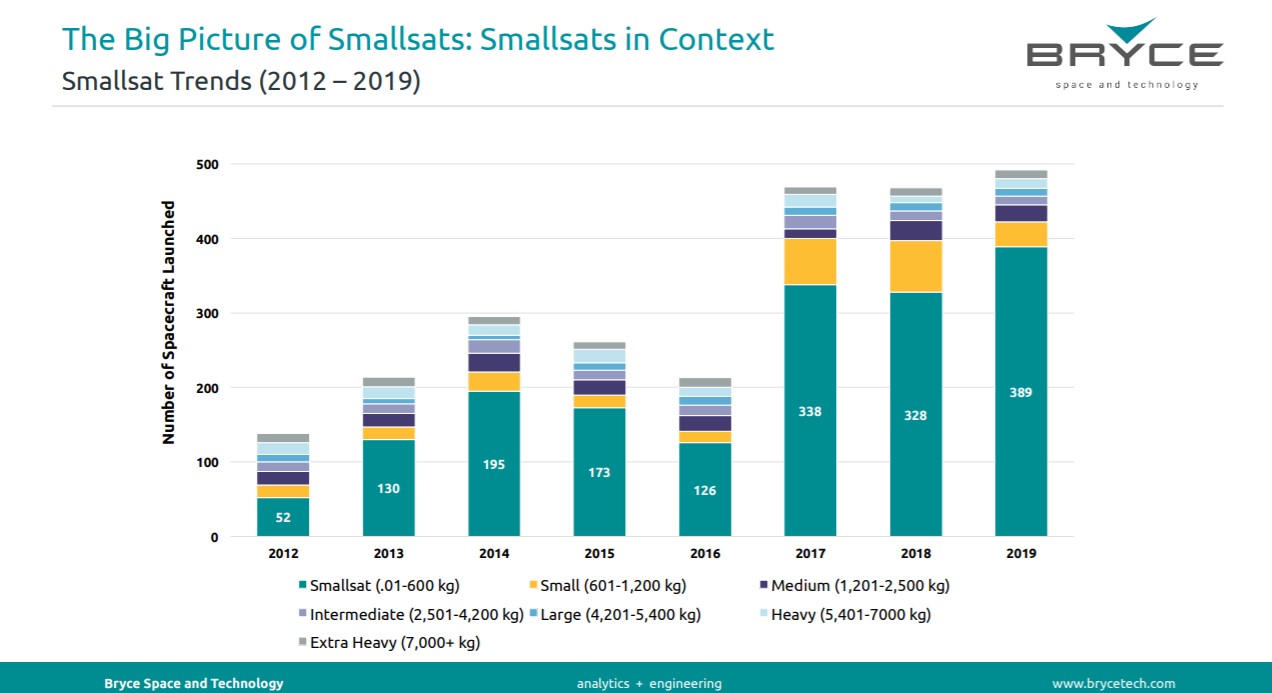
Source: Smallsats by the Numbers2020 | BRYCE space and technology
The breakdown shows that commercial satellites accounted for 62% of the total number of microsatellites launched in 2019, up from 6% in 2012, indicating that the use of microsatellites for commercial purposes has been growing rapidly in recent years.
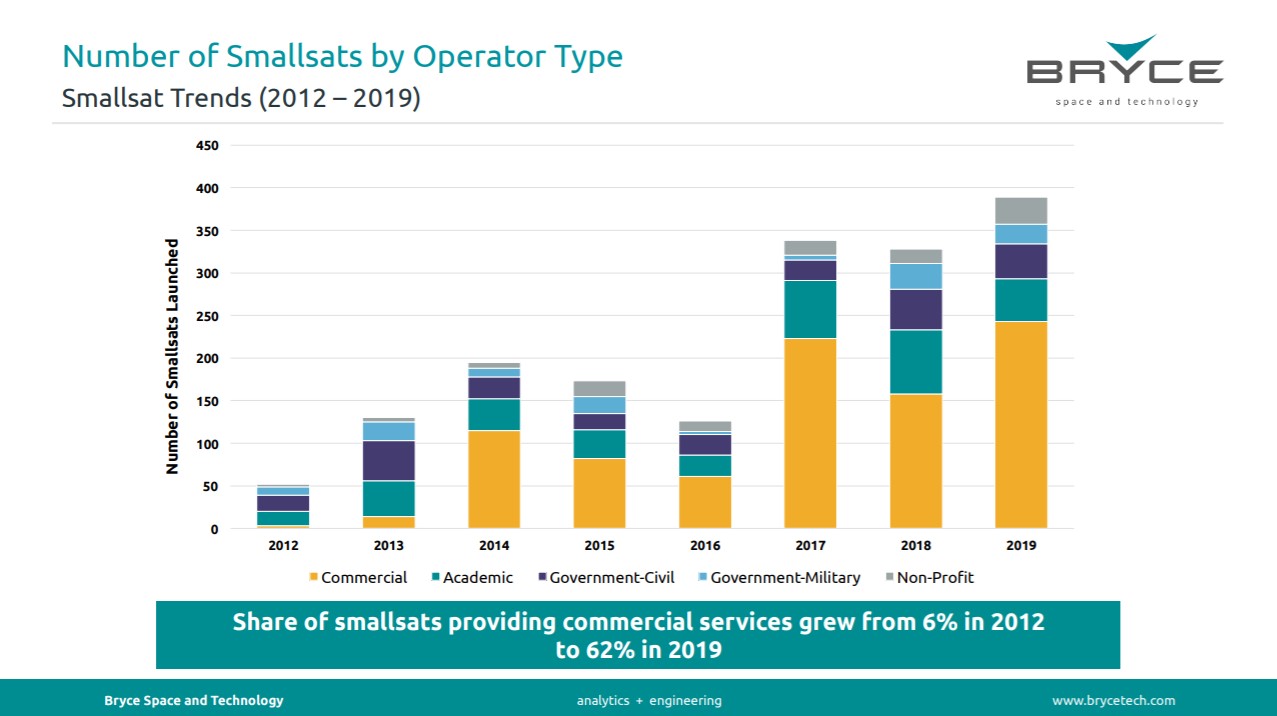
Source: Smallsats by the Numbers2020 | BRYCE space and technology
In addition, of the commercial satellites, Planet, SpaceX, and Spire account for 43%, 14%, and 13% of the market, respectively, in 2019.
Communications satellites, such as the Flock satellite from Planet Lab, which launched 88 satellites in 2017, and the Starlink satellite from SpaceX, make up a large proportion of the total.
Commercial satellites are also becoming more and more constellated, for example, Flock satellites monitor the Earth optically in real time, and Starlink satellites deploy a more powerful communications network than ever before.
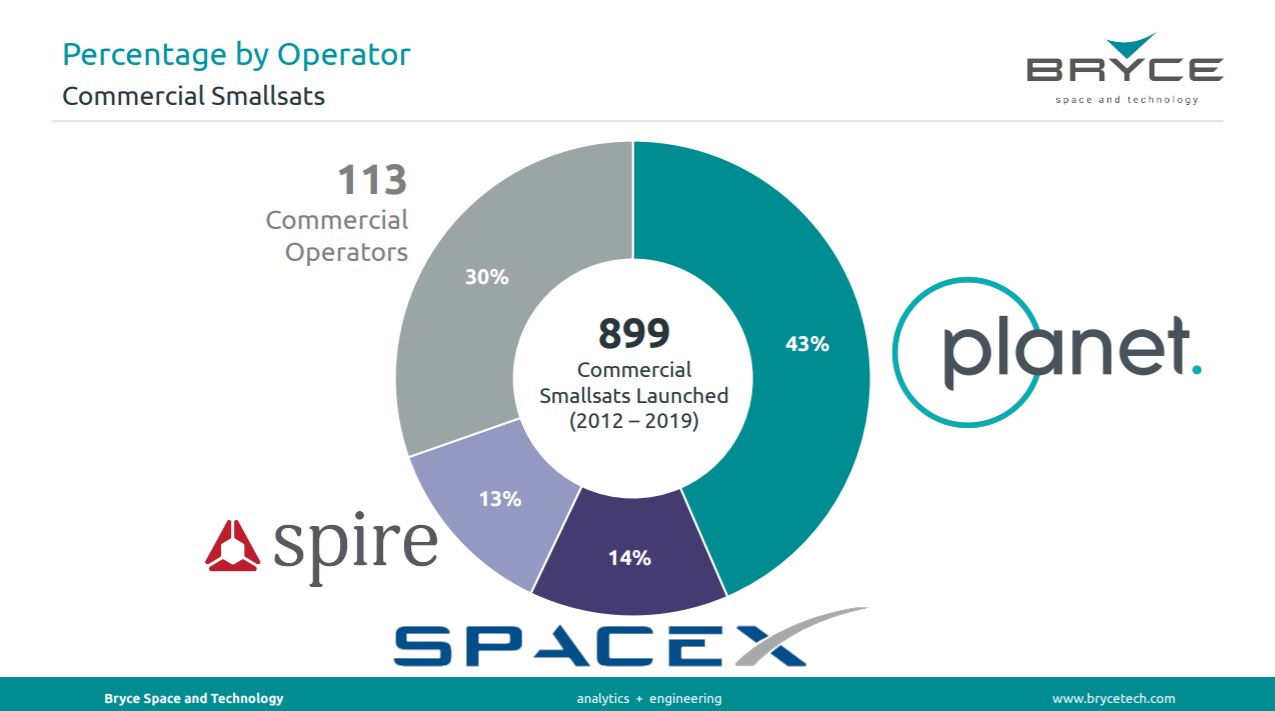
Source: Smallsats by the Numbers2020 | BRYCE space and technology
2-2. Microsatellite market size
The market size of the space business is about 29 trillion yen. Of this, microsatellite is said to account for $ 271 billion, or 2.7 trillion yen, according to the 2019 report. Of this, 45% of the business is based on satellite services and 58% on ground equipment.
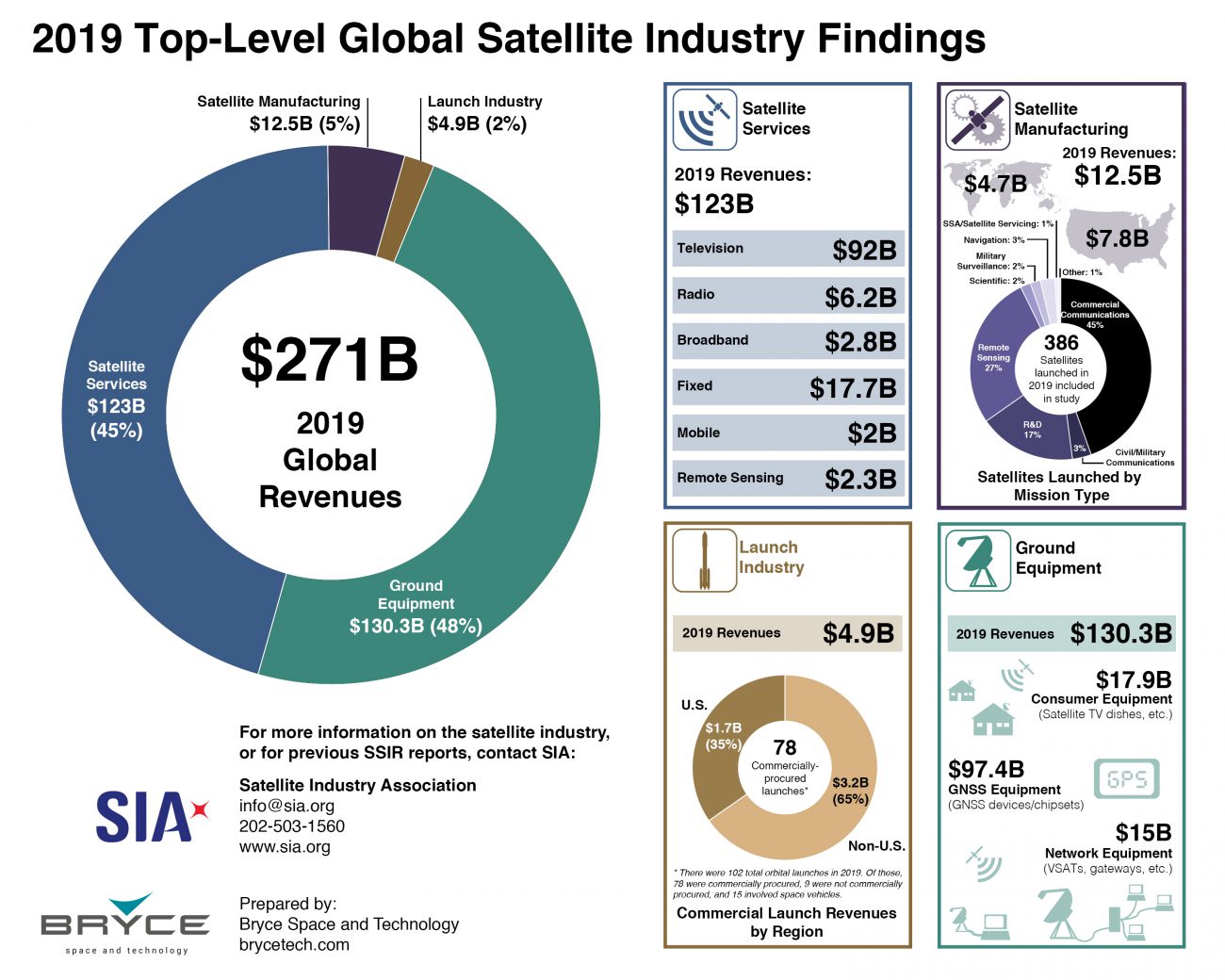
Source: State of the Satellite Industry Report | The Satellite Industry Association (SIA)
2-3. Who are the players in the microsatellite market?
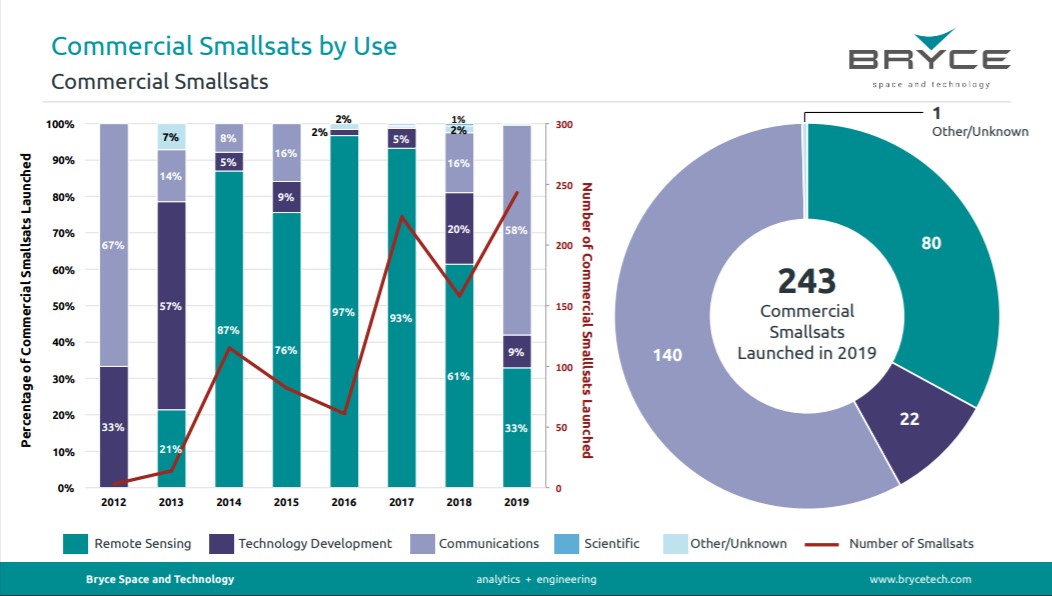
Source: Smallsats by the Numbers2020 | BRYCE space and technology
Now, let’s look at the market players.
As for commercial satellite applications, from 2014 to around 2017, most of the launches of earth observation satellites were for remote sensing purposes.
But in 2019, the number of communication satellites has increased significantly. The SpaceX’s Starlink satellites, first launched in 2019, marked the 15th successful launch on October 6, 2020, bringing the total number of satellites launched to more than 900.
In addition, the number of piggyback launches for microsatellite has increased from about 10% around 2012 to about 20% in 2019. This may also have contributed to the increase in the number of launches.
Also, in recent years, we have seen many large companies like Canon Electronics, Amazon Web Services, or Sony that were not originally involved in the space industry enter the space market. These trends are expected to further increase the demand for space applications.
3. Applications of microsatellites
Let’s take a look at how microsatellites are specifically used in different fields of application.
Microsatellites are mainly used in the fields of communications, technology development, military and intelligence, remote sensing and scientific observation.
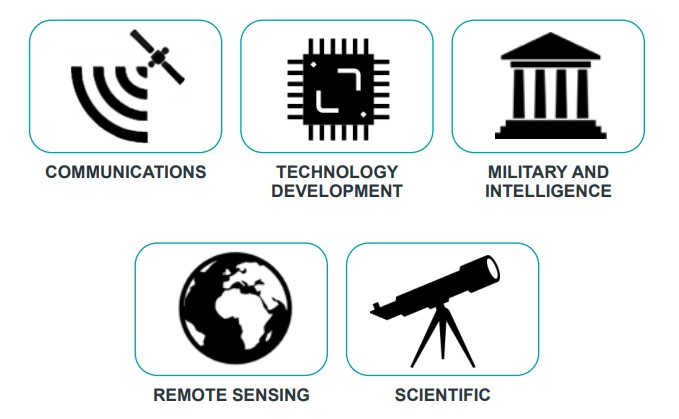
Source: Smallsats by the Numbers2018 | BRYCE space and technology
3-1. Communications/IoT
In the field of communications, one example is SpaceX’s Starlink satellite, which has a plan to constellate 12,000 microsatellites into space orbit. The aim is to create a communication network in high latitudes where the Internet is unavailable and to achieve stronger and faster communication than ever before.
Since microsatellites are inexpensive and can be launched in large numbers at a time, the more they are launched, the more they can cover the earth “like a web with no gaps.”
SpaceX plans to launch the service in the northern United States and Canada in 2020, and in the following year, it will be ready to cover almost all populated areas.
Another example is IoT satellites, which take advantage of the large number of bases placed in orbit to enable constant communication with IoT sensors on the ground.
IoT satellite is a system that incorporates sensors into a network by collecting pieces of information from sensors placed on the ground or at sea using satellite and sending them collectively to the ground. It is physically difficult to collect data from sensors around the world, but artificial satellites orbiting the earth can easily communicate with and collect data from sensors around the world.
3-2. Technology development/Education purposes
As an example of technology development and educational purposes, I would like to introduce a past mission in which the Japanese Experiment Module “Kibo” on the International Space Station (ISS) released microsatellites.
Each time a resupply spacecraft is planned to be launched to the ISS, a public call is made for satellites to be released. Satellites built by universities or by companies not launching large satellites but wanting to prove the technology of satellites are launched.
To take advantage of this opportunity, there have been many microsatellites made for educational purposes in universities. For students, developing a microsatellite is a great opportunity to gain the experience needed to be an engineer. Today, this system is often used for technology demonstrations.
3-3. Remote sensing
Remote sensing is the act of sensing (investigating) an object from a remote location without touching it. It involves remote control not only in space, but also on Earth, such as drones and airships.
Satellites can observe large areas from the sky at once.
There are a variety of remote sensing observation methods, and microsatellite sensors can be broadly classified into two types: passive sensors and active sensors.
Passive sensors, which use reflections from sunlight and other light sources to make observations, are basically used for daytime observations only. Specifically, they are used for optical observations.
By contrast, active sensors transmit radio waves from a satellite and observe the radio waves reflected from a target, such as the Earth’s surface. As they are not affected by clouds and day and night, they can make observations 24 hours a day. This type of sensor is employed in radio observations and SAR.
SAR (synthetic-aperture radar) observes radio waves transmitted by satellites that are reflected back at the earth’s surface.
The disadvantage of SAR satellites is that they observe and transmit radio waves by themselves, which consumes a lot of power, and thus they were only installed on large satellites, but recent technological developments have made it possible to install them on microsatellites. If you want to know a more detailed classification of the observation method, see also the following article.
Some of the companies that are well known for each observation method discussed in this article include Planet Labs (optical observations), Spire (radio observations), and ICEYE (SAR observations). Among Japanese companies, NEC’s Satellite is also famous. The following article covers the SAR satellites in detail.
Next, I would like to introduce an example of optical observation in Japan. The AXELSPACE’s satellite WNISAT-1R monitors seasonal changes in Arctic ice to provide a safe route for ships to avoid sea ice. Specifically, by combining WNISAT-1R’s observations with existing satellite data, it predicts the state of the sea ice throughout the year.
Weathernews, a long-time supporter of the shipping industry, has invested in AXELSPACE, and this initiative is in regular operation as a joint project.
ウェザーニューズ、「北極海の海氷傾向2020」を発表 北東航路は8月中旬、北西航路は9月中旬に開通する見込み
Other examples are discussed in detail in 4. Microsatellites in the spotlight
3-4. Scientific observation
Microsatellites are also used for scientific observations. Until now, microsatellites were only available in Earth’s orbit, but PROCYON, developed by the University of Tokyo, has proven that it is possible to go into deep space(*). PROCYON was launched in 2014 as a piggyback satellite on Hayabusa 2. It had a mission to pass near an asteroid using the ion engine, but engine malfunction prevented it from happening.
However, it was the first to successfully demonstrate the basic functions of a microsatellite in deep space, far from the Earth. Currently, a team led by the University of Tokyo is developing a new deep-space microsatellite, EQUULEUS.
*Deep Space: generally refers to a place at a distance of more than 2 million km from the Earth. The distance from the earth to the moon is 380,000 km, so it is more than four times that distance.
3-5. Other new applications
Now that anyone can launch a microsatellite, there are more and more opportunities to try out different uses for one.
Some examples include ALE, which aims to use space for entertainment by artificially shooting stars, and ASTROSCALE, which aims to use microsatellites to clean up space debris, which has become an international problem.
4. Microsatellites in the spotlight
This section explains specifically what kind of microsatellites of what companies are in the spotlight.
4-1. Communications/IoT
- Myriota (Australia)
Operating 50 satellites using CubeSats, Myriota obtains data in IoT centers on the ground and uploads them in the cloud, allowing users to utilize them.
A satellite orbiting 600 km from the ground receives a large number of signals from ground modules simultaneously, and the data collected in the cloud can be accessed from anywhere on Earth by accessing the cloud using an API.
This allows users to monitor distant locations, such as measuring the state of the sea with a buoy in the middle of the ocean and analyzing the water level in a remote tank to inform the owner.
In March 2020, Myriota signed an AIS data agreement with exactEarth, a Canadian company, and launched the following service. ExactEarth is a leading provider of Satellite AIS Data Services for vessel tracking and maritime situational awareness. In Japan, IHI Jet Service Co., Ltd. is the exclusive distributor of this data. Satellite AIS data service collects and provides position and speed data sent by the Automatic Identification System (AIS) on board a vessel.
With that agreement, exactEarth announced that it has signed an agreement to sell four satellites and a ground station from its first-generation constellation to Myriota Canada Inc. This further accelerates Myriota’s IoT plans.
- Kepler (Canada)
Kepler is a Canadian venture company founded with the goal of establishing a communications network in space by building telecommunications towers for cellphones using satellite constellations. It establishes real-time communication with other satellites, space stations, rockets, etc. Examples of services offered by the company are listed below.
Global Data Service
It provides latency-tolerant (latency-resistant) data communication capabilities by optimizing satellite bandwidth using low-orbit satellites, making communication services fast, cheap, and easy to use. It is also developing “everywhereIOT,” a satellite connection module for use on the ground as well as in satellites.
Following the launch of GEN1 in 2018, the third satellite, TARS, was launched on September 3, 2020, improving the level of global data services. By adding a narrow band in addition to the traditional Ku band, TARS has become the first company to offer both Ku and narrow bands from low earth orbit (LEO).
It plans to launch 10 GEN1 satellites in FY 2020 for a total of 140 constellations.
4-2. Technology development/Education purposes
As examples of technology development, here are some past missions on the microsatellites released from Kibo on the International Space Station.
- The University of Tokyo "AQT-D"
In general, satellites use chemical engines or electric propulsion engines, such as ion engines, which often contain substances toxic to the human body as propellants. To this end, the University of Tokyo is developing a microsatellite using water as a propellant, so harmless to the human body.
- Kyushu Institute of Technology / Nanyang Technological University (Singapore)
“SPATIUM-I”
The purposes of the mission are to verify the operation of an atomic clock in space for installation on a microsatellite and to demonstrate the technology of the system for mapping the ionosphere.
It is also an advantage of microsatellites that the technology aimed at miniaturization can be tested in space to see if it works.
As these two examples show, microsatellites allow us to take advantage of their low cost and ease of launch to launch and demonstrate new systems that have never been tested in space before.
4-3. Remote sensing
- Optical observation: Planet Labs
Planet Labs is an American company that provides earth observation data. It has already launched more than 300 satellites and currently operates 200 microsatellites.
Its distinguishing feature is the range of daily imaging; it takes images of the Earth with a resolution of about 3 to 5 m every day. Previously, fine resolution and high-frequency observations were not feasible, so when Planet built its Earth observation network, the term “real-time Google” came into use.
The data provided comprises a variety of data on the Earth and is used for agriculture, capital economy and resources, forest observations, contributions to map data, and other purposes. Also, the company uses machine learning to analyze vast amounts of data.
Planet is also unique in the way it builds satellites. While conventional satellites have been carefully designed, manufactured and tested before they are launched, Planet has adopted the agile development philosophy in its satellite development. By repeating the cycle of launching a satellite, operating it, identifying issues, improving it, and then re-launching it, and by managing the version of the satellite, it avoids unnecessary work and makes satellite development cheaper.
- SAR observation: ICEYE's "ICEYE-X1"
The world’s first sub-100 kg SAR satellite, ICEYE-X1, was just launched in 2018. ICEYE has successfully completed a constellation with three satellites and plans to launch a total of 18 satellites in the future.
For providing satellite images, it usually takes 24 hours from image acquisition to data delivery. But for urgent requests, data can be provided in a few hours, which shows the immediacy of the service.
In addition, in March 2020, ICEYE succeeded in creating a video by taking continuous SAR images, which had only been available as still images.
The number of images a satellite can take for a single point is very small and it has been difficult to produce video, but ICEYE has made this possible with its unique technology.
This video captures the slow movement of ships and cars.
ICEYE also announced in October 2020 that it would release about 18,000 SAR images from the past. The images can be opened in a mapping system such as Google Earth once the order is placed.
- Radio observation: Spire
Spire mainly provides three types of information: vessel position information (AIS), aircraft position information, and atmospheric occultation information. Information on vessel and aircraft operations serves the needs of the logistics industry, whether on land, at sea or in the air. The occultation observation involves “scanning the atmosphere” by exchanging radio waves between the Spire’s satellites across the Earth’s atmosphere. Using a receiver of signals sent from a navigation satellite such as GPS, the satellite observes the temperature and the amount of water vapor in the atmosphere from the refraction of the received signals.
In June 2020, Spire signed an agreement with NASA to provide its data for one year. It currently operates 88 satellites in orbit.
Other advantages of using microsatellites for remote sensing include that multiple satellites can be placed in orbit to increase the frequency of observations and to conduct joint missions.
More case studies can also be found here.
4-4. Scientific observation
- Canon Electronics "CE-SAT-Ⅰ"
A microsatellite launched by Canon Electronics, an opto-electronic manufacturer, performs optical Earth observation. The images of the Earth taken with the Canon camera mounted on the first satellite are very beautiful.
Canon plans to mass-produce such microsatellites and sell the components and image data.
Company website: Canon Electronics
- EQUULEUS: EQUilibriUm Lunar-Earth point 6U Spacecraft
It is a bit far into the future, but the University of Tokyo has a plan to explore beyond the Earth’s orbit with a microsatellite.
The three major scientific observation missions are as follows.
The first is to capture an overall image of the Earth’s magnetospheric plasma with extreme ultraviolet light from a distance away from the Earth. From the Lagrangian point, where the gravity of the Moon and the Earth have a special relationship, the team will try to capture an overall picture of the Earth, which has never been possible with microsatellites.
The second is to observe lunar impact flashes on the backside of the Moon. Lunar impact flash, a flashing phenomenon caused by an object crashing into the lunar surface, will be studied in detail to determine the implications for future lunar manned space exploration.
The third is to evaluate the dust environment in cis-lunar space (the space from the Earth to the lunar orbit). Together with the dust observations in the above mission, the team will investigate the solid matter (dust) temporarily trapped in the gravitational field of the Earth and Moon.
These EQUULEUS missions are expected to usher in a new era where microsatellites, which have so far operated only in the vicinity of the Earth, will be operated away from the Earth’s orbit.
4-5. Other new applications
- ALE Co., Ltd. "ALE-1"
Microsatellites are also being used for entertainment.
ALE Co., Ltd. aims to generate an artificial shooting star at a specified time and place with its satellite ALE-1. In addition to such developments in entertainments, it also plans to analyze the upper atmosphere using the luminescence of artificial shooting stars.
ALE has completed the launch of ALE-2 so far, but there was a problem with the ejection mechanism of the grains that are the source of shooting stars, so it will test them again on the third one, which will next be launched.
Company website: ALE Co., Ltd.
4-6. Summary
We presented examples of the use of microsatellites in different fields. They are just a few of the world’s microsatellites. All these services are expected to make it easier to demonstrate new technologies in space by taking advantage of the features of microsatellites.
The possibilities of microsatellites are infinite depending on who uses them; Canon’s example shows that a company can develop a new business by applying its unique technology to space.
You may be able to further develop your expertise or realize what you want to do.
If this article has raised your interest, keep an eye out for the application cases of the microsatellites featured here and other space news that will appear on Sorabatake in the future.
List of satellites featured in this article

5. How to develop microsatellites
We have looked at detailed microsatellites cases, but many of you may think it impossible to imagine yourself launching one.
Surprisingly, there are kits that you can make a microsatellite yourself or those with the basic parts already built.
The price for a kit is around 1 million yen, depending on the situation. The cost of the launch starts at 3 million yen for a 1U release from the ISS. (About 500 million yen for a rocket launched by itself)
If you can buy a kit, think about a mission, and get a chance to launch, you may be able to start a new business in space.
Finally, here are the companies offering the kit.
- OPUSAT-KIT (Japan)
It is a 1U size kit built using the basic functions (bus function) of the microsatellite OPUSAT launched mainly by Osaka Prefecture University. Since everything except the mission equipment is assembled to work, all you have to do is to build the mission equipment and modify the bus equipment to fit it.
- makesat.com (Japan)
Infostellar sells products for satellite development. In addition to the bus equipment needed for a satellite, it offers almost everything you need: launch services, ground stations, and even opportunities for testing to see if a satellite can withstand the vibrations of a rocket and the space environment when it is launched. Infostellar operates a cloud-based ground station service and can share opportunities for communication with ground station satellites around the world.
- Cubesatshop (Netherlands)
Cubesatshop is a website selling components for microsatellites operated by ISIS (Innovative Solutions in Space BV), a Dutch company founded by the people involved in the project at Delft University of Technology in the Netherlands. The website is like the “Amazon” of the microsatellite industry, allowing various companies to sell parts. There are about 28 vendors, and you can compare and purchase more than 100 products. The feature of this website is that equipment is almost always priced, while other websites often require you to inquire about the price.
- GOMSPACE (Denmark)
GOMSPACE is a Danish company that sells satellite components. In addition to equipment, it also sells ground stations, structures, and software, which are not limited to 1U but are also available in larger sizes.
- Space BD (Japan)
Space BD does not sell components, but it offers integrated support including the formulation of a satellite mission, production, and the provision of launch opportunities. In 2019, it was selected as the only operator that offered opportunities for the piggyback launch of the H-2A and H3 rockets.
One thing to keep in mind when building your own satellite is that the components must be made for space. Some parts, if launched directly into space, would produce harmful gases (outgassing) due to radiation or could not withstand the temperature difference.
You should also remember that the most important thing is the ground station after you manage to launch the satellite. The satellite, no matter how well it is working, will be nothing if it cannot communicate with the ground. In general, you are allowed to communicate with a microsatellite by contracting certain frequencies of amateur radio. So, you will also need a radio certification.
About ten years ago, it was difficult for the general public to build a satellite, but now you can buy one as a service. If you want to use a certain component of your company in space, you can buy the rest of the components, or if you want to focus solely on the mission, you can buy a kit. As such, there are various options to suit your convenience.
The opportunities to utilize space are quite open to both people who think space is something they have no connection to, and those who would like to try it if the opportunity arose.
6. Summary
We have discussed microsatellites in this article. Microsatellites, which can be built inexpensively and quickly, have greatly reduced the barriers to utilizing space. Nowadays, the satellite-based business and the ground station business dominate the microsatellite market. The current market size, currently at 2.7 trillion yen, will continue to grow.
Moreover, it turns out that microsatellites can be used in a wide range of fields, depending on the ideas of the users.
Nearly 20 years have passed since the University of Tokyo and the Tokyo Institute of Technology successfully launched the world’s first microsatellite in 2003. And now we live in a world where microsatellites are available to many people around the world, not just to universities.
Microsatellites can be mass-produced, which makes it possible to do a variety of things, and the market is getting bigger and bigger with companies that have been involved in the space business from the beginning and those that have newly entered.
Space is of unknown potential where unexpected projects can actually be realized.
Consider using microsatellites as a “means” to solve your issues.


